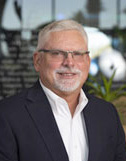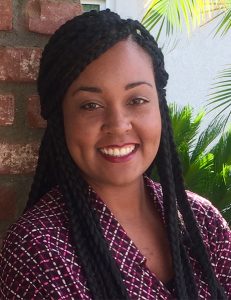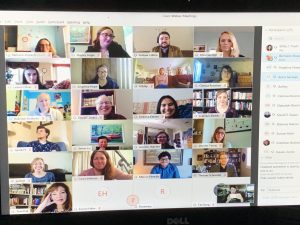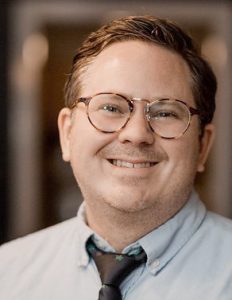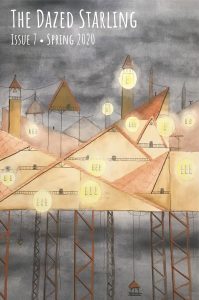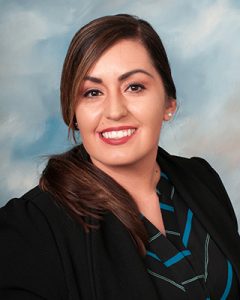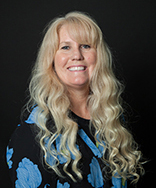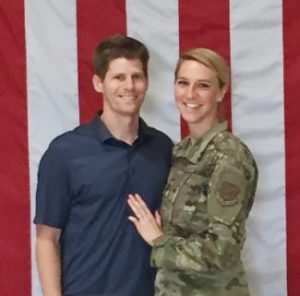In this issue…
Current News
UCO’s “Sing the Story” creates virtual choir experience
Despite being quarantined, members of the University Choir and Orchestra (UCO) at California Baptist University remotely produced a virtual choir video experience for its latest release, “Sing the Story (Hallelujah Amen).” The video, released shortly before Easter, quickly became a source of encouragement throughout the CBU community and beyond.
With CBU switching to remote instruction for the remainder of the spring semester due to the coronavirus pandemic, most of the students participated in the project from home. CBU students were commissioned to produce individual recordings in 24 hours. In all, 58 students participated in the project.
Travis Maclay, assistant professor and director of operations at Shelby and Ferne Collinsworth School of Music, edited and completed the final product. In editing, he took all the individual video and audio recordings and synchronized them. He also designed an on-screen layout that would incorporate all the students in addition to John Bolin, who led the worship song. The video was released on YouTube on April 11.
“We were excited to have the unexpected opportunity to continue our collaboration with LifeWay Worship,” said Steven Dahlgren, the UCO conductor. “There’s a strong message in this song that the world needs to hear, especially during this pandemic.”
“Sing the Story (Hallelujah Amen)” was co-written by Hector Gabriel, assistant professor of music, and John Bolin, a member of the School of Music’s worship arts steering board. The song was arranged by Bolin and orchestrated by Bradley Knight.
Gabriel said he started to write the song four years ago; then Bolin, a year ago, helped him finish the song. The song had been recorded by the UCO in October 2019, for release in May 2020. However, because of its Easter theme and the emerging trend of virtual choirs, the team thought it would be a good opportunity to release the song this way, Gabriel said.
“The epic thought was that there is a host of angels and saints gathered around the throne of God, worshipping. We wanted to paint that picture and give the church an opportunity to be a part of it,” Gabriel said.
Allie Holliday, a public relations freshman and a soprano for UCO, said she viewed the project as a ministry opportunity.
“Many people have commented on how impactful it was for them while stuck in quarantine,” Holliday said. “The final project was awesome. I loved seeing so many of my choir friends and feeling like we had done something together again even though we are spread across the U.S.”
Delaney Young, a music education junior and one of UCO altos, admitted it was a bit awkward singing her part alone.
“I think it was a great opportunity for UCO to continue to be able to create music together while being separated from each other,” Young said. “I thought that the final project was great. It was fun to be able to see everyone come together to create this project.”
“Sing the Story (Hallelujah Amen)”
Words and Music by John Bolin and Hector Gabriel
Arranged by John Bolin
Orchestrated by Bradley Knight
We sing the story
Of one so holy
Who spun the stars into the night
He raised the mountains
And carved the valleys
He reigns in righteousness and light
We sing the story
Of one so lowly
A humble King in manger lay
He lived among us
And healed the broken
The Prince of peace who came to save
Chorus
Hallelujah, all heaven sing
Hallelujah, to Christ our King
Hallelujah, again and again
Hallelujah, amen
We sing the story
Of blood and mercy
The sacrifice for sinners slain
But on that morning
Just as he promised
The Lamb of God rose from the grave
The Lamb of God rose from the grave
We sing the story
Of when in glory
We’ll see our Savior face to face
We’ll bow before Him
And sing forever
The endless song of love and grace
To purchase, go to https://www.lifeway.com/en/product/sing-the-story-hallelujah-anthem-P005824660
Professor’s start-up company awarded research grant
 Dr. Matthew Rickard, a professor at California Baptist University, believes he is on the verge of developing breakthrough technology in the area of blindness prevention.
Dr. Matthew Rickard, a professor at California Baptist University, believes he is on the verge of developing breakthrough technology in the area of blindness prevention.
Rickard, CEO for a start-up company, Globe Biomedical, recently received a boost to his research for a wearable eye health monitoring system. The company was awarded a National Science Foundation (NSF) Small Business Innovation Research Phase II grant for approximately $715,000. The funding includes a $40,000 subaward for CBU engineering students to help conduct testing of the technology.
The grant will allow Globe Biomedical to continue its research and development work that infuses eyeglass technology with built in monitors that track and report remotely on a person’s eye pressure readings. Rickard said his technology is designed to track a patient’s risk of glaucoma—the most common cause of irreversible blindness—that is associated with increase in pressure within the eye.
“We at Globe are very excited to have the opportunity to continue serving the medical community through the development our eye health monitoring system,” said Rickard, professor of bioengineering.
The wearable system is based on patent-pending technology developed at CBU in the Gordon and Jill Bourns College of Engineering.
While the actual product is two to three years away, Rickard said the goal is to have a version of the glasses ready for trial runs by the end of the year.
This is the second NSF grant awarded to Globe. Nearly a year ago the company received funding for $224,000.
Rickard said receiving the additional grant is exciting, especially for his start-up company located in Riverside.
“It’s critical for early stage technology development to have early-on investment,” Rickard said. “This NSF program is a perfect balance of government-funded research but directed toward commercialization. It creates jobs and spends it locally.”
CBU accommodates students during pandemic closure
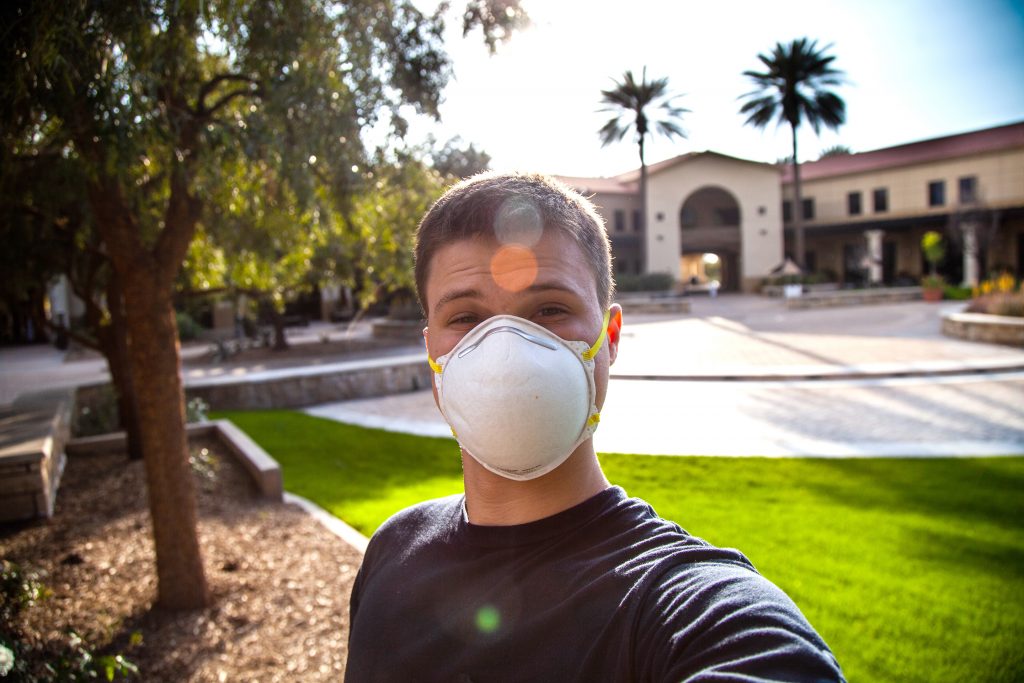 While the campus at California Baptist University remains closed due to the coronavirus pandemic, some students are still living on campus due to their unique circumstances.
While the campus at California Baptist University remains closed due to the coronavirus pandemic, some students are still living on campus due to their unique circumstances.
Kirk Bernal, associate director of Residence Life, said CBU accommodated some students’ requests to stay on campus. For instance, some international students wished to remain on campus since returning home might put them more at risk of contracting COVID-19. Other students whose parents who are missionaries or work overseas find themselves in similar circumstances as their international peers.
Luc Stringer, a journalism and new media sophomore, is one of the students still living on campus. His parents are missionaries with the International Mission Board.
“I keep expecting to walk outside and see the throngs of students rushing to class,” Stringer said. “Seeing people walk around in masks all the time is such a new experience.”
Stringer said he passes his leisure time through photography and connecting with his friends and family remotely.
“I have never spent so much time on my phone talking to people. I think I might even talk to people more now that everyone is trying to keep a semblance of community electronically,” Stringer said.
To better serve the students remaining on campus, most were moved to The Point or Lancer Arms, Bernal said.
Relocating the students has made the campus feel less empty, said Adeline Charley, a graphic design senior. Most of her time is spent doing schoolwork by remote instruction. In her free time, she watches TV or plays video games.
“I stay connected through phone calls and messaging or FaceTime,” Charley said.
Bethany Brodwolf, a graphic design sophomore, also is living on campus during the closure.
“Seeing campus almost empty is so strange. It’s so quiet and there are no skateboarders zooming by,” Brodwolf said.
Brodwolf said she is filling her days with prayer, art, Disney movies, exercise and Zoom meetings.
“I’ve been so grateful for technology, because that is how I’ve been keeping in touch with family and friends,” Brodwolf said.
Daron Hubbert, director of Residence Life and Housing Services, said his team is encouraging all students—those still on campus and off—to stay engaged and connected through social media with the communities that were formed in the living areas before the pandemic.
“We have been trying to just remain in contact with students. A personal phone call or email goes a long way,” Hubbert said.
Keeping CBU community connected
While the CBU community is doing its part by working remotely, we want to make sure Lancers stay connected. Here is a glimpse of how staff and faculty members do this while working from home.
Sandy Frazer, NCAA Financial Aid Coordinator in Financial Aid
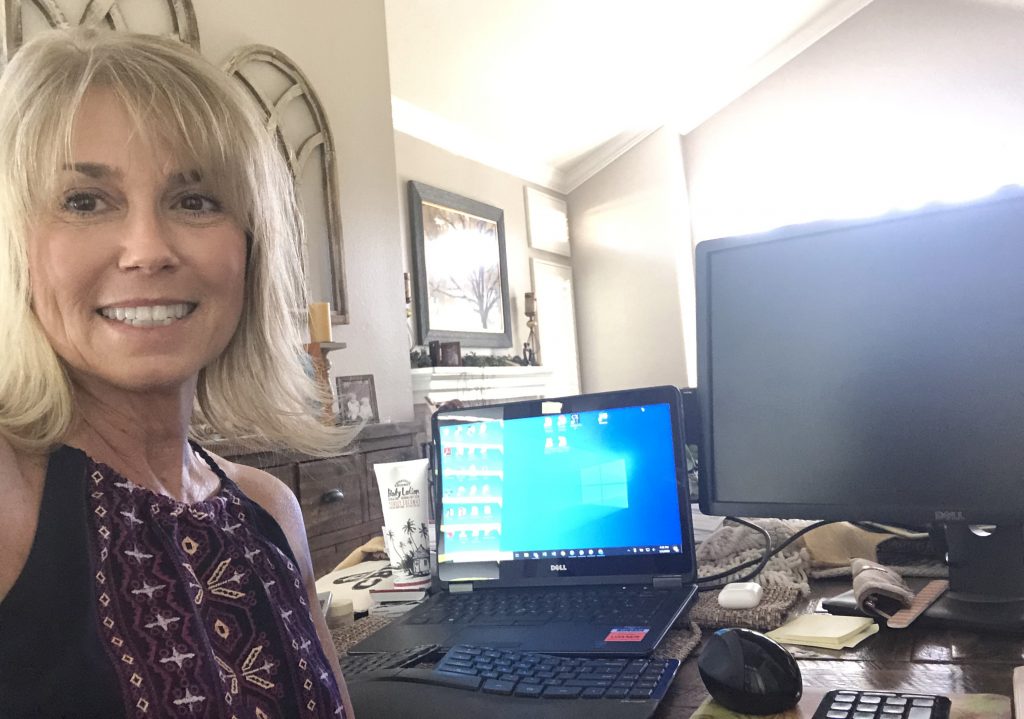 Describe where you work at home.
Describe where you work at home.
I work in my living room on our dining room table. I have the pool to the back of me and beautiful trees to the front of me. It’s a very bright and happy room. Beside me on the floor sits a little dog bed for Abby, my miniature dachshund.
How are you staying connected with your department and students?
Our office remains in constant communication through our Webex teams. We are keeping up with awarding, adjusting and helping our families with all of their questions. We have live Webex meetings a couple times a week so we can see each other and how we are all making it through this time. It is good for encouragement and any prayer requests that are needed.
What is one thing you miss from working on campus?
I miss being able to go to the Rec Center at lunch for Group X classes, and I miss our Friday morning donuts in the office.
Do you have children at home? How do you balance being a parent and working at home?
I have twins who are attending medical schools who get to be home now and tackling their classes online. It’s good to have them home. On our down time we play games, do puzzles, swim, cook and watch movies together.
What is your snack of choice at home?
Usually cashews and paleo chocolate chip cookies we have been baking.
During a WebEx meeting or class, has a family member or pet stolen the show?
During some of our WebEx meetings, my husband will stand behind the monitor and try to make me laugh. And it seems my twins always need something while I am live on meetings. Age seems to never change that.
Dr. Erin Smith, associate professor of psychology
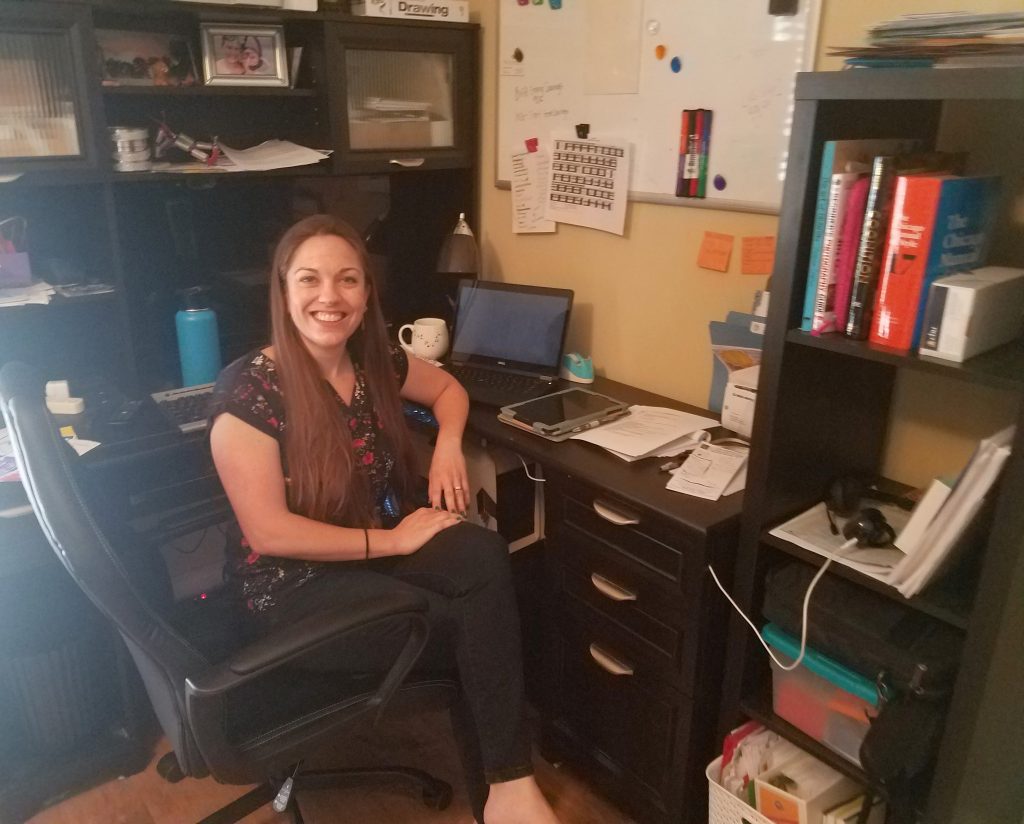 Describe where you work at home.
Describe where you work at home.
I can be found in our home office, using multiple screens. I find that I also work from my phone in the kitchen, the hallway, the couch, etc.
How are you staying connected with your department and students?
Our department has a weekly devotion and daily coffee WebEx meeting. I, unfortunately, can’t attend these because of the time. To stay connected with students, I use email and Blackboard, primarily and have met with a few via WebEx. I have tried to over communicate without overwhelming. Overall, I’m really proud of my students’ resilience in this moment.
What is one thing you miss from working on campus?
On the small side, I miss my office. I have a set-up that plays to my style of work. On the other side of the spectrum, I miss the separation of work and home. Even more than that, I miss the relationships. I miss conversations in passing, seeing students’ eyes light up when they have that “a ha” moment in a class. I miss the opportunities to offer encouragement to my colleagues and students face-to-face.
Do you have children at home? How do you balance being a parent and working at home?
With three (ages 7, 4½, and 11 months), balance is hard under optimal circumstances. In moments like these it isn’t possible. At least not balance as in “equally balanced” time-wise. My husband isn’t working from home, so on a good day I have an hour when the kids’ naps or schoolwork all magically align, when I can work. I do most of my work on the evenings, weekends, or the few days that my husband has taken as vacation. In these past few weeks I have been living in the constant reality of Matthew 6:25-34 and Lamentations 3:22-24. When things don’t go as planned or I have been particularly consumed by anxiety or frustration, God’s mercies are new tomorrow. For that, I am so, so grateful.
What is your snack of choice at home?
Two answers: The snacks I eat in front of my kids—pita chips and hummus—and the snacks I smuggle when they aren’t looking. The latter are far more exciting. I’ve taken to making chocolates, recently, so I smuggle chocolate Bordeaux and strawberry buttercreams. Or homemade cookies I put in the freezer that my kids thought just disappeared.
During a WebEx meeting or class, has a family member or pet stolen the show?
Not really. The closest I have come was a child who didn’t even get in view (because she knew she should have been napping!). Also, the cats aren’t allowed in the office—they destroy our electronic cords.
Family Updates
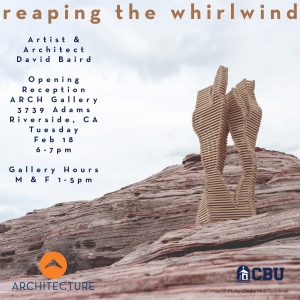 The Architecture Gallery featured its first professional exhibit this spring. The exhibit had work by professional artist/architect David Baird, a professor of architecture and former program director at the University of Nevada, Las Vegas, School of Architecture. The exhibit, which opened Feb. 18 in the Gallery, located in the architecture building at 3739 Adams Ave., can be seen in this walk through.
The Architecture Gallery featured its first professional exhibit this spring. The exhibit had work by professional artist/architect David Baird, a professor of architecture and former program director at the University of Nevada, Las Vegas, School of Architecture. The exhibit, which opened Feb. 18 in the Gallery, located in the architecture building at 3739 Adams Ave., can be seen in this walk through.
Dr. Stephen Christie, associate professor of accounting and finance, had a book review published in Strategic Finance (April). The article, titled Transformation Tips, reviewed Leading Transformation by Nathan Furr, Kyle Nel and Thomas Zoëga Ramsøy.
Dr. Krystal Hays, assistant professor of social work, published an article in the Journal of Pastoral Care and Counseling (March 2020). It was titled Lived Experience, Transparency, Help, and Humility: Four Characteristics of Clergy Responding to Mental and Emotional Problems.
The CBU chapter of Sigma Tau Delta (English National Honor Society), Alpha Tau Sigma, inducted eight new members in a virtual ceremony on April 16. The current officers organized and facilitated the ceremony. English faculty and family members joined too. The inductees were: Joanna Ingold, Jacob Haffner, Dakodah Boehnke, Elisheva Keener, Ashley Moore, Giselle Espinosa, Lauren Oliver and Jennifer Hatcher.
Russell Meek, adjunct professor of Christian studies for Online and Professional Studies, won the Evangelical Press Association’s first prize in biblical exposition for his article Break the Teeth in Their Mouths, O God in Fathom Magazine (Sept. 23, 2019).
The English department hosted an online BFA Senior Capstone Reading and Dazed Starling Journal release and open mic on April 28. The winners of the creative writing contest were also announced: Fiction Winner—The Untamed by Megan McGaughey; Fiction Honorable Mention—Promises by Mariah Mooring; Nonfiction Winner—Sing the the Sky by Hayley Angle; and Poetry Winner—Transcendental by Megan McGaughey.
Dr. Sandra Romo, associate professor of communication, and Dr. Shannon Leinen, adjunct professor of communication, both for Online and Professional Studies, presented their research at the virtual annual meeting for the National Social Science Association on April 6. Their research was titled The Silent Killer: A Media Analysis of Anti-Vaping Initiatives in Media.
Dr. Jennifer Costello, assistant professor of social work, successfully defended her dissertation on April 20. She earned a Doctorate of Behavioral Health from Arizona State University. Her dissertation was on Screening and Addressing Social Determinants of Health in Primary Care: Impact on Health Outcomes.
Michael Osadchuk, director of the University Tutoring Center, was a guest on a Student Success Heroes podcast by Engineerica Systems on May 1. He talked about the Tutoring Center’s pivot to virtual tutoring during the pandemic.
Capt. Rebekah Howe, daughter of Dr. John Marselus, professor of aviation science, is a nurse in the U.S. Air Force Reserves, stationed at Luke Air Force Base (Arizona). Last month, Howe was deployed to New York City to help in the fight against Covid-19. She is working at the Javits Convention Center that was transformed into a hospital.
Dylan VanBuskirk married Casey Moyer on March 7 at The Farm in Norco. He is the son of Patty VanBuskirk, department secretary in communication arts.
Personnel Updates
